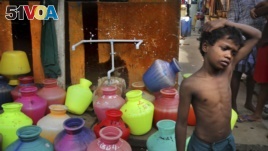09 August, 2019
One in four people around the world is at risk of facing dangerous water shortages, an American research organization warned Tuesday. India is at the highest risk.
Seventeen countries face "extremely high water stress" because they use 80 percent of their available water each year. The situation is made worse by a rise in dry periods linked to climate change, the World Resources Institute or WRI said.

In this Thursday, July 18, 2019, photo, a boy waits at a water distribution point in Chennai, capital of the southern Indian state of Tamil Nadu. (AP Photo/Manish Swarup)
"We're currently facing a global water crisis," said Betsy Otto, director of WRI's global water program.
New information from WRI's Aqueduct Water Risk Atlas showed the countries suffering most are in and around the Middle East and North Africa.
The WRI Atlas is a risk-mapping tool that helps governments, companies, investors, and other users understand where and how water risks arise worldwide.
Qatar is the most water-stressed country, followed by Israel and Lebanon.
India is 13th among "extremely high" water-stressed nations. But with a population of more than 1.3 billion, it has more than three times the people in the other 16 countries combined. In those countries, agriculture, industry and cities depend on avoiding water "bankruptcy."
Water bankruptcy means there is no possibility of full recovery from water shortages.
India's sixth-largest city, Chennai, was the latest city worldwide to warn it could be without water, as water storage levels fell.
That followed similar announcements from South Africa's Cape Town last year and Brazil's Sao Paulo in 2015.
"We're likely to see more of these kinds of 'Day Zeros' in the future," said Otto.
Many things threaten the world's water supplies, from climate change to poor supervision, WRI said.
High dependence on groundwater supplies, which are decreasing, is an added concern, Paul Reig told reporters. He leads work on the Aqueduct Water Risk Atlas. Reig noted groundwater supplies are difficult to measure and manage because they are deep below the Earth's surface.
Nearly a third of the world's fresh water is groundwater. That information comes from the U.S. Geological Survey, a government agency.
"Because we don't understand (groundwater), and don't see it, we manage it very poorly," Reig said.
WRI's Atlas listed 189 countries in order of water stress, drought and river flood risk. The organization worked with universities and research organizations in the Netherlands and Switzerland, using information from the 1960s to 2014.
I'm Alice Bryant.
Reuters News Agency reported this story. Alice Bryant adapted it for Learning English. Caty Weaver was the editor.
_____________________________________________________________
Words in This Story
water stress – n. when the demand for water exceeds the available amount during a period or when poor quality restricts use
global – adj. involving the entire world
reservoir – n. a usually manmade lake that is used to store a large supply of water for use in people's homes and in businesses
manage – v. to have control of something, such as a business, department, sports team